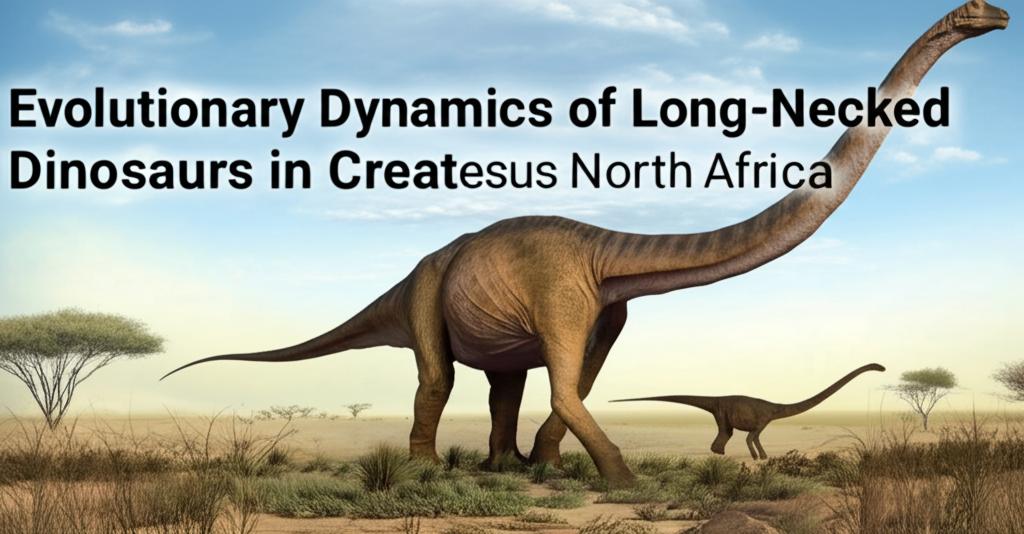Cretaceous North Africa was a vibrant and diverse ecosystem for long-necked dinosaurs, also known as sauropods. Recent discoveries and ongoing research continue to shed light on their evolution, diversity, and the world they inhabited.
A Thriving and Diverse Fauna:Contrary to earlier assumptions that dinosaur diversity was declining globally towards the end of the Cretaceous period, evidence from North Africa, particularly Morocco, suggests a different story. Fossil discoveries, including those of titanosaurs (a group of advanced sauropods), indicate that biodiversity was flourishing in this region just before the Cretaceous-Paleogene extinction event that wiped out the non-avian dinosaurs 66 million years ago.
These long-necked herbivores coexisted with a rich array of other dinosaurs, including predatory abelisaurids (the southern counterparts to tyrannosaurs), small duck-billed dinosaurs (hadrosaurids like Ajnabia odysseus), and other theropods. The presence of numerous predator species suggests a robust and healthy ecosystem with abundant herbivores to support them.
Key Discoveries and Insights:- Moroccan Discoveries: Phosphate mines in Morocco, particularly in the Ouled Abdoun Basin near Casablanca, have proven to be a treasure trove of Late Cretaceous fossils. While marine reptiles like plesiosaurs and mosasaurs dominate these marine deposits, dinosaur remains, including those of an unnamed titanosaur, offer crucial insights into the terrestrial fauna. The co-occurrence of terrestrial dinosaurs in marine sediments is a fascinating area of study, suggesting that these animals lived near coastal environments or their remains were washed out to sea.
- Egyptian Finds: Discoveries in Egypt's Western Desert, such as Mansourasaurus shahinae, have also been pivotal. Mansourasaurus was a titanosaur roughly the size of a city bus that lived during the Late Cretaceous (around 70-80 million years ago). Its anatomy suggests connections with European sauropods of the same period, challenging the idea that African dinosaur faunas were completely isolated. This indicates possible land connections or faunal exchange routes between Africa and Europe during this time.
- Dental Evidence: Studies of isolated sauropod teeth from the Kem Kem beds of Morocco and equivalent strata in Algeria (dating to the Albian-Cenomanian, around 113–93.9 million years ago) have revealed different tooth morphotypes. These suggest the presence of various sauropod groups, including titanosauriforms, titanosaurs, and rebbachisaurids. Similarities between these North African tooth types and those found in latest Cretaceous deposits of the Ibero-Armorican Island (Southern Europe) further support the hypothesis of faunal connections across the Tethys Sea.
- Earlier Cretaceous Sauropods: Lower Cretaceous (Neocomian, ~135 million years ago) fossils from Niger have revealed broad-toothed sauropods with fewer specializations than later Cretaceous forms. In contrast, younger Aptian-Albian (~110 million years ago) deposits from the same region have yielded small-bodied rebbachisaurid diplodocoids with highly modified skulls, showcasing the evolutionary changes within sauropod lineages over time in Africa.
The evolutionary story of North African sauropods is intertwined with the breakup of the supercontinent Gondwana and the subsequent isolation and reconnection of landmasses.
- Gondwanan Affinities: Some African titanosaurs, like Shingopana songwensis from Tanzania (Cretaceous Period, 70-100 million years ago), show closer evolutionary relationships to South American titanosaurs than to other African sauropods found further north. This suggests that southern Africa's dinosaur fauna during the Cretaceous may have had stronger links to South America.
- Euro-Gondwanan Connections: As mentioned, evidence from Mansourasaurus and tooth morphology points towards faunal exchange between North Africa and Southern Europe during the Late Cretaceous. Temporary land bridges or even the ability of some dinosaurs to swim across marine barriers may have facilitated these migrations, contributing to the observed diversity.
The Late Cretaceous dinosaur fauna of North Africa is still relatively less understood compared to those of North America and Asia. However, each new discovery adds crucial pieces to the puzzle. Researchers are continually studying new fossils, suggesting that the known diversity represents only a fraction of the actual dinosaur fauna that once roamed the region.
The picture emerging from Cretaceous North Africa is one of a dynamic and diverse sauropod fauna that thrived until the very end of the dinosaur era. Their evolution was shaped by shifting continental configurations and local environmental conditions, leading to unique adaptations and a complex web of life. Future research promises to further unravel the evolutionary dynamics of these magnificent long-necked giants.

